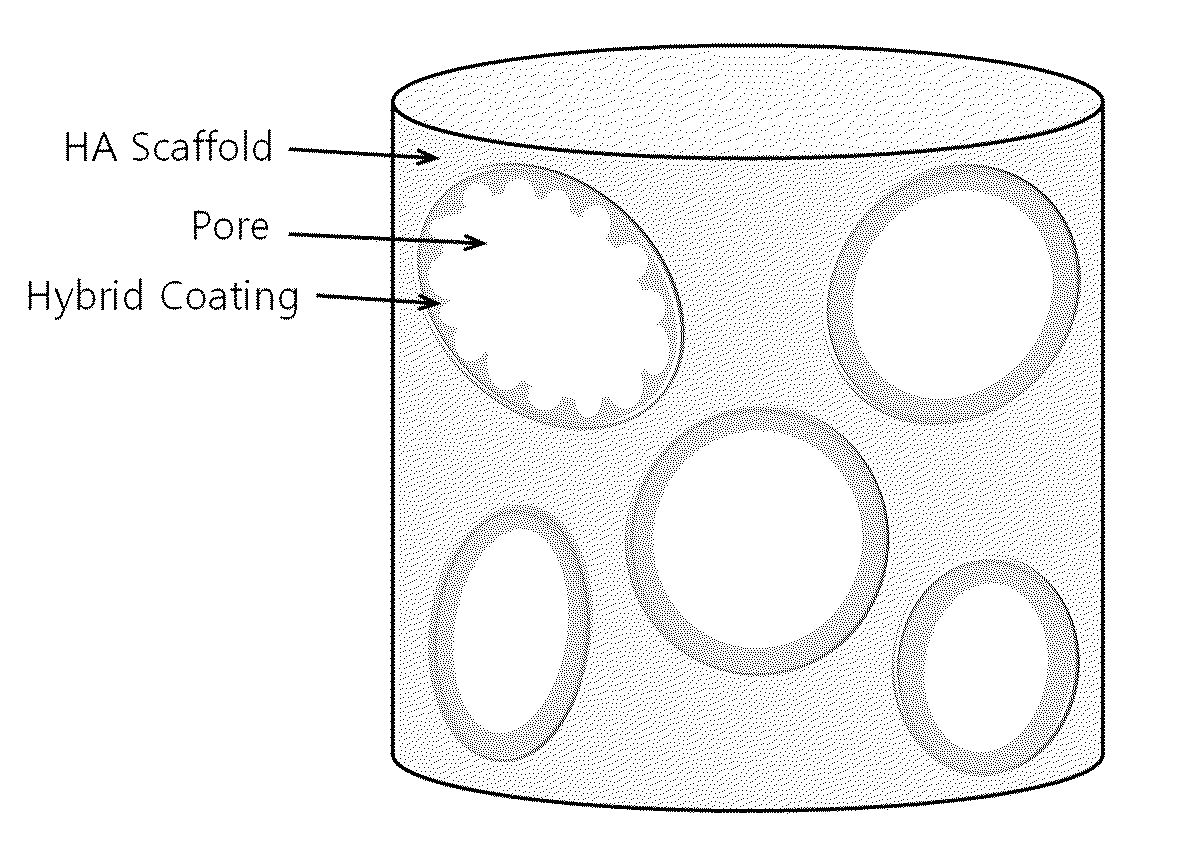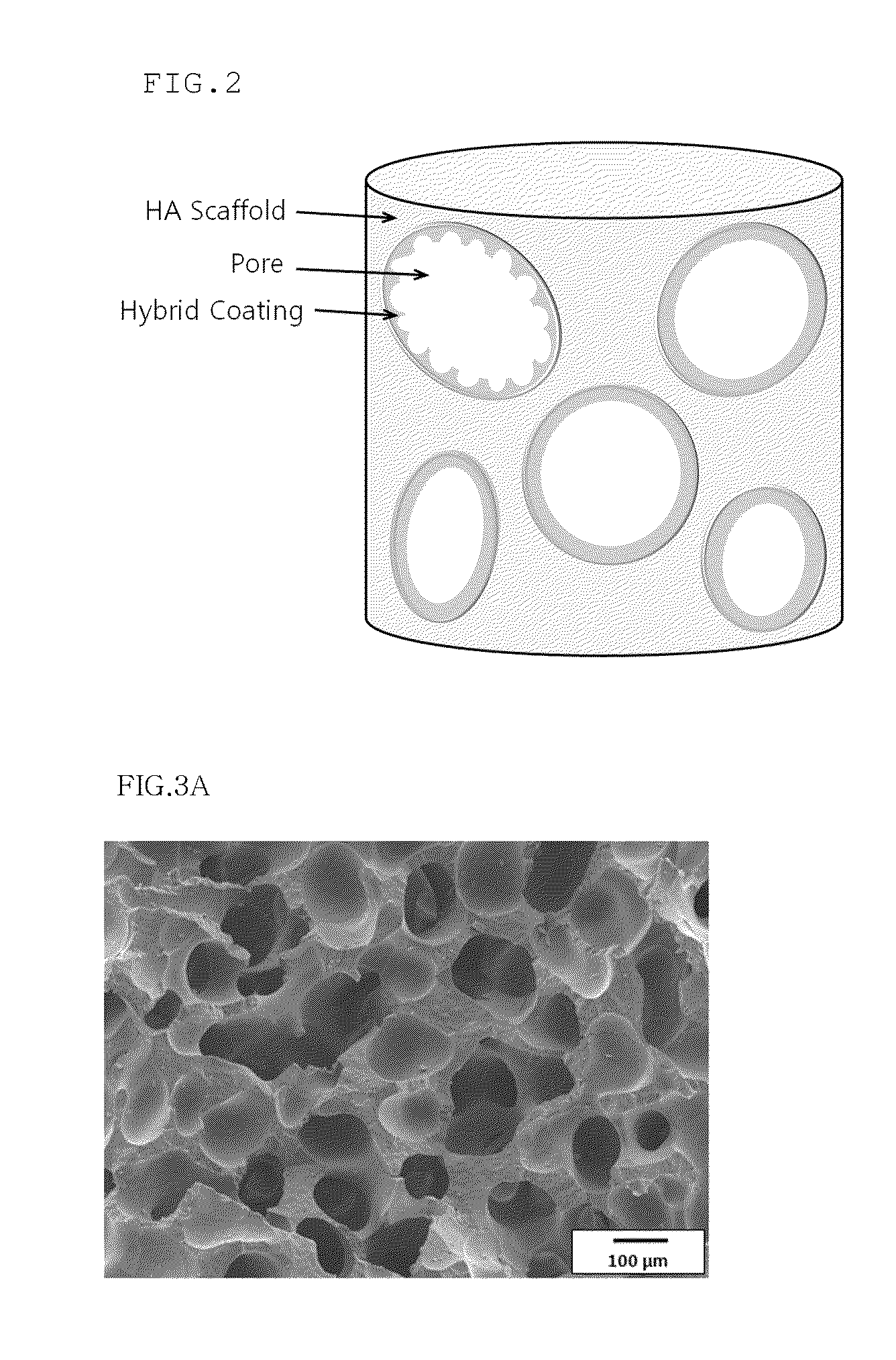Method for manufacturing a porous ceramic scaffold having an organic/inorganic hybrid coating layer containing a bioactive factor
a technology of organic/inorganic hybrid and porous ceramics, which is applied in the direction of organic active ingredients, peptide/protein ingredients, depsipeptides, etc., can solve the problems of insufficient amount of autogenous bones to recover overall bone defects, limitation of bioactive factors, and disadvantages of allogeneic bones in causing infection or infectious diseases, etc., to achieve favorable biocompatibility and bioactivity of porous ceramic scaffolds, easy to add, and increase surface area of ceramic scaffolds
- Summary
- Abstract
- Description
- Claims
- Application Information
AI Technical Summary
Benefits of technology
Problems solved by technology
Method used
Image
Examples
example 1
[0042]In Step 1, hydroxyapatite was treated in a solvent comprising camphene, using a ball-mill at 60° C. for 3 to 6 hours. Herein, a content of ceramic may be controlled to 10 to 40 parts by volume. The prepared ceramic slurry was poured into a mold to impart a predetermined morphology thereto, was casted at 44° C. for 3 days. In this regard, casting time may be controlled to 1 to 5 days depending upon desired pore size. The casted green-body was immediately frozen at −70° C. and, after removing the mold, was subjected to drying while maintaining a vacuum condition at −60° C., in order to remove camphene. Thereafter, the freeze-dried hydroxyapatite was sintered at 1300° C. for 3 hours, thus forming a porous ceramic scaffold.
[0043]In Step 2, a silica alkoxide, water and hydrochloric acid (1N) as a catalyst were prepared and agitated at 400 to 600 rpm for 1 hour, to synthesize a silica xerogel. Then, a chitosan solution in an amount corresponding to 50% (by volume) of a hybrid compos...
example 2
[0046]The same procedure as described in Example 1 was executed, except that a quantitative amount of bone morphogenic protein (BMP) was added as a bioactive factor to be loaded in the organic / inorganic hybrid composite, followed by agitation. The amount of the added BMP was 100 μg / ml relative to a total volume of a final organic / inorganic hybrid composite.
experimental example
Structure of a Porous Ceramic Scaffold having an Organic / Inorganic Hybrid Composite Coating Layer Containing a Bioactive Factor
[0047]FIG. 3A is a scanning electron microscope (SEM) image that shows a surface of a porous hydroxyapatite (HA) formed through freeze-drying using camphene, which was manufactured in Step 1 of Example 1, and FIG. 3B is an enlarged SEM image that shows a pore part of a porous ceramic scaffold having a coating layer formed of an organic / inorganic hybrid composite containing a bioactive factor (a drug), manufactured in Example 1. As such, it can be seen that the organic / inorganic hybrid substance is uniformly applied throughout a surface of the scaffold having pores.
Phase Analysis of Porous Ceramic Scaffold having an Organic / Inorganic Hybrid Composite Coating Layer Containing a Bioactive Factor
[0048]FIG. 4 is graphs showing results of qualitative analysis of elements contained in porous ceramic scaffolds through energy dispersive spectroscopy (EDS), wherein th...
PUM
| Property | Measurement | Unit |
|---|---|---|
| temperature | aaaaa | aaaaa |
| temperatures | aaaaa | aaaaa |
| concentration | aaaaa | aaaaa |
Abstract
Description
Claims
Application Information
 Login to View More
Login to View More - R&D
- Intellectual Property
- Life Sciences
- Materials
- Tech Scout
- Unparalleled Data Quality
- Higher Quality Content
- 60% Fewer Hallucinations
Browse by: Latest US Patents, China's latest patents, Technical Efficacy Thesaurus, Application Domain, Technology Topic, Popular Technical Reports.
© 2025 PatSnap. All rights reserved.Legal|Privacy policy|Modern Slavery Act Transparency Statement|Sitemap|About US| Contact US: help@patsnap.com



